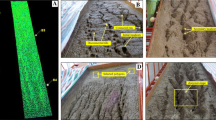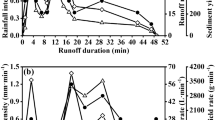Abstract
Cross-sectional morphology is an effective approach for calculating rill volume and revealing the mechanism for rill development. In this study, the law governing the temporal–spatial variation in rill cross-section (RCS) under interbedded clay and gravel conditions was investigated by a scouring experiment. A high-flow scouring experiment was conducted in a field plot under heterogeneous soil conditions in the Yuanmou Dry-Hot Valley using 3D laser scanning and ArcGIS techniques. Morphological index system including the size and derived proportional parameters was established to accurately reveal the dynamic process of the rill erosion–sediment sections based on temporal–spatial scale. The study indicated that the RCS size under gravel and soil aggregates showed an irregular variation over different periods, and the variation of RCS morphology tends to be nonlinear. The area of rill cross-section at the middle of the rill was much larger than that of the rill head and the rill mouth, and the fluctuations in RCS along the rill depended heavily on the soil texture heterogeneity. In addition, there were extreme variations in rill erosion direction for different rill parts, i.e., rill head, body, and mouth, and the highly significant asymmetry in RCS distributed along the rill under increasing scouring duration in the Yuanmou Dry-Hot valley. Temporal variations in RCS morphology were opposite to spatial variations by comparing the same morphology parameter. Nonlinear fluctuation trends and asymmetric shapes were observed in the variation of RCS on slopes with soils and gravels.





Similar content being viewed by others
References
Bennett SJ (1999) Effect of slope on the growth and migration of headcuts in rills. Geomorphology 30:273–290
Bennett SJ, Gordon LM, Neroni V, Wells RR (2015) Emergence, persistence, and organization of rill networks on a soil-mantled experimental landscape. Nat Hazards 79:7–24
Berger C, Schulze M, Riekezapp D, Schlunegger F (2010) Rill development and soil erosion: a laboratory study of slope and rainfall intensity. Earth Surf Process Landf 35:1456–1467
Bewket W, Sterk G (2003) Assessment of soil erosion in cultivated fields using a survey methodology for rills in the Chemoga watershed, Ethiopia. Agric Ecosyst Environ 97:81–93
Bruno C, Stefano CD, Ferro V (2010) Field investigation on rilling in the experimental Sparacia area, South Italy. Earth Surf Process Landf 33:263–279
Brunton DA, Bryan RB (2015) Rill network development and sediment budgets. Earth Surf Process Landf 25:783–800
Bryan RB, Govers G, Poesenb SRA (1989) The concept of soil erodibility and some problems of assessment and application. CATENA 16:393–412
Cao L, Zhang K, Yin L (2014) Factors affecting rill erosion of unpaved loess roads in China. Earth Surf Process Landf 39:1812–1821
Capra A, Stefano CD, Ferro V, Scicolone B (2010) Similarity between morphological characteristics of rills and ephemeral gullies in Sicily, Italy. Hydrol Process 23:3334–3341
Eltner A, Baumgart P, Maas HG, Faust D (2015) Multi-temporal UAV data for automatic measurement of rill and interrill erosion on loess soil. Earth Surf Process Landf 40:741–755
Foster GR (1982) Modelling the erosion process. In: Haan CT, Johnson HP, Brakensiek DL (eds) Hydrologic modeling of small watersheds, ASAE Monograph No. 5, American Society of Agricultural Engineers, St. Joseph, pp 297–380
Frankl A, Poesen J, Scholiers N, Jacob M, Haile M, Deckers J, Nyssen J (2013) Factors controlling the morphology and volume (V)—length (L) relations of permanent gullies in the Northern Ethiopian Highlands. Earth Surf Process Landf 38:1672–1684
Gabet EJ, Bookter A (2008) A morphometric analysis of gullies scoured by post-fire progressively bulked debris flows in southwest Montana, USA. Geomorphology 96:298–309
Gao P (2011) Mountain and hillslope geomorphology|Hillslope erosion: rill and gully development processes. In: Shroder J (ed) Treatise on geomorphology. Elsevier, San Diego
Gilley JE, Kottwitz ER, Simanton JR (1990) Hydraulic characteristics of rills. Trans Asae 33:1900–1906
Giménez R, Planchon O, Silvera N, Govers G (2010) Longitudinal velocity patterns and bed morphology interaction in a rill. Earth Surf Process Landf 29:105–114
Govers G (1992) Relationship between discharge, velocity and flow area for rills eroding loose, non-layered materials. Earth Surf Process Landf 17:515–528
Green AN, Goff JA, Uken R (2007) Geomorphological evidence for upslope canyon-forming processes on the northern KwaZulu-Natal shelf, SW Indian Ocean, South Africa. Geo Mar Lett 27:399–409
Hao H, Guo Z, Wang X, Zhan H, Ma R, Li Z, Jiang J (2017) Rill erosion process on red soil slope under interaction of rainfall and scouring flow. Trans Chin Soc Agric Eng 33:134–140
Hao H, Guo Z, Li Z, Hua L (2018) Characteristics of rill cross-section morphology and hydrodynamics on red soil slope. Res Environ Yangtze Basin 27:363–370
He J-J, Ye LU, Li GH, Cai QG (2013) Experimental study on rill erosion characteristics and its runoff and sediment yield process. J Hydraul Eng 44:398–405
He J-J, Sun LY, Gong HL, Cai QG, Jia LJ (2016) The characteristics of rill development and their effects on runoff and sediment yield under different slope gradients. J Mt Sci 13:397–404
Heede B (1970) Morphology of gullies in the Colorado rocky mountains. Int Assoc Sci Hydrol Bull 15:79–89
Li H (2015) Study on the evolution of rill cross section morphology. Northwest Sci Tech Univ Agric For. Thesis for Master's Degree, Xi'an City, China
Li Z, Qing B, Kang W, Li P, Li W, Wei X (2008) Indoor experimental studies on hydrodynamic characteristics of runoff in rill erosion procession steep slope. Trans Chin Soc Agric Eng 24:64–68
Liu Y, Zhu X, Zhou P, Tang K (1988) The laws of hillslope channel erosion occurrence and development on Loess Plateau. Res Soil Water Conserv 7:9–18
Loch RJ, Donnollan TE (1989) Rill erosion of a self-mulching black earth.1. Effects of tillage Australian. J Soil Res 27:525–534
Ma X, Zhang K, Yang F, Yang M, Dong X (2017a) Influencing factor analysis of rill erosion section morphology development on slope and its dynamic characteristic experiment. Trans Chin Soc Agric Eng 33:209–216
Ma X, Zhang K, Yang F, Yang M, Dong X (2017b) Influencing factor analysis of rill erosion section morphology development on slope and its dynamic characteristic experiment. Trans Chin Soc Agric Eng 33(208):209–216
Mahmoodabadi M, Ghadiri H, Yu B, Rose C (2014) Morpho-dynamic quantification of flow-driven rill erosion parameters based on physical principles. J Hydrol 514:328–336
Mancilla GA, Chen S, Mccool DK (2005) Rill density prediction and flow velocity distributions on agricultural areas in the Pacific Northwest. Soil Tillage Res 84:54–66
Meyer LD, Foster GR, Huggins LF (1984) A laboratory study of rill hydraulics: 1. Velocity relationships. Trans Asabe 27:790–796
Moore ID, Burch GJ (1986) Sediment transport capacity of sheet and rill flow: application of unit stream power theory. Water Resour Res 22:1350–1360
Nearing MA, Foster GR, Lane LJ, Finkner SC (1989) A process-based soil erosion model for USDA-Water Erosion Prediction Project technology. Trans Asae 32:1587–1593
Ran H, Deng Q, Zhang B, Hui L, Lei W, Luo M, Qin F (2018) Morphology and influencing factors of rills in the steep slope in Yuanmou Dry-Hot Valley (SW China). CATENA 165:54–62
Rejman J, Brodowski R (2010) Rill characteristics and sediment transport as a function of slope length during a storm event on loess soil. Earth Surf Process Landf 30:231–239
Rustomji P (2006) Analysis of gully dimensions and sediment texture from southeast Australia for catchment sediment budgeting. CATENA 67:119–127
Shen H, Zheng F, Wen L, Jia L, Jiang Y (2015a) An experimental study of rill erosion and morphology. Geomorphology 231:193–201
Shen H, Zheng F, Wen L, Jiang Y, Jia L (2015b) Effects of rainfall intensity and slope gradient on rill morphological characteristics. Trans Chin Soc Agric Mach 46:162–170
Sheng H, Sun L, Cai Q (2017) Impact of rill morphology on hillslope erosion for Loess soils. J Basic Sci Eng 25:679–688
Slattery MC, Bryan RB (1992) Laboratory experiments on surface seal development and its effect on interrill erosion processes. Eur J Soil Sci 43:517–529
Stefano CD, Ferro V, Pampalone V, Sanzone F (2013) Field investigation of rill and ephemeral gully erosion in the Sparacia experimental area, South Italy. CATENA 101:226–234
Stefano CD, Ferro V, Pampalone V (2016) Measuring field rill erodibility by a simplified method. Land Degrad Dev 27:239–247
Stefano CD, Ferro V, Palmeri V, Pampalone V (2018) Testing slope effect on flow resistance equation for mobile bed rills. Hydrol Process 32:664–671
Wang G, Bai Y, Jia Z, Wei Z, Li J (1988) A preliminary study on the characteristics of the development and erosion of the rill. Soil Water Conserv China 5:13–16
Wang L, Cai Q, Cai C, Sun L (2014) Morphological changes of rill on loess slope and its relationship with flow velocity. Trans Chin Soc Agric Eng 30:110–117
Wang J, Li H, Meng Q, Wang Y, Zhang Q (2015) Characteristics of rill cross section morphology, hydrodynamics and sediment-carrying capacity on Loess slopes. J Soil Water Conserv 29:32–37
Xue J, Wang J, He LI, Wang Y, Zhou M (2016) Experimental analysis of development regularities of rill erosion on heavy silty loam sloping surface. J Irrig Drain 35:69–72
Yan D, Wen A, Shi Z, Ming SU, He X (2010) Critical slope length and control of rill occurrence on cultivated land of purple soil in Sichuan Basin. Res Soil Water Conserv 17:1–4
Yang M, Walling DE, Tian J, Liu P (2006) Partitioning the contributions of sheet and rill erosion using beryllium-7 and cesium-137. Soil Soc Am J 70:1579–1590
Yermolaev OP, Gafurov AM, Usmanov BM (2018) Evaluation of erosion intensity and dynamics using terrestrial laser scanning. Eurasian Soil Sci 51:814–826
Yuan L, Chang C (2008) A cellular automata approach to the simulation of rill self-organizing development process on hillslope. Res Soil Water Conserv 15:7–9
Zhang K, Tang K (2000) A study on hydraulic characteristics of flow for prediction of rill detachment capacity on loess slope. Acta Pedol Sin 37:9–15
Zhang Y, Wu Y, Liu B, Zheng Q, Yin J (2007) Characteristics and factors controlling the development of ephemeral gullies in cultivated catchments of black soil region, Northeast China. Soil Tillage Res 96:28–41
Zhang F, Yang M, Walling DE, Zhang B (2014) Using Be-7 measurements to estimate the relative contributions of interrill and rill erosion. Geomorphology 206:392–402
Zhang P, Yao W, Tang H, Xiao P (2018) Rill morphology change and its effect on erosion and sediment yield on loess slope. Trans Chin Soc Agric Eng 34(116):114–119
Acknowledgements
This study was supported by the Project of Science and Technology Department of Sichuan Province (2018SZ0337, 2017JY0189), the Project of Sichuan Provincial Department of Education (18TD0025, 18AZ0465), the Meritocracy Research Funds of China West Normal University (17YC134, 17YC105), the Fundamental Research Funds of China West Normal University (17C032, 16A001), and the National Natural Science Foundation of China (41971015).
Author information
Authors and Affiliations
Corresponding author
Ethics declarations
Conflict of interest
The authors declare that they have no conflict of interest.
Additional information
Publisher's Note
Springer Nature remains neutral with regard to jurisdictional claims in published maps and institutional affiliations.
Rights and permissions
About this article
Cite this article
Wang, N., Ding, L., Liu, G. et al. Variation of rill cross-sections with gravel and aggregating soil in the Dry-Hot Valley (SW China). Model. Earth Syst. Environ. 5, 1239–1252 (2019). https://doi.org/10.1007/s40808-019-00632-9
Received:
Accepted:
Published:
Issue Date:
DOI: https://doi.org/10.1007/s40808-019-00632-9




